
Inequality is of concern for at least three reasons. First, lower inequality per se is an objective for a decent society. Second, lower inequality improves the efficiency of economic growth in achieving poverty reduction. Third, high inequality impedes growth itself, through its impact on social cohesion and the investment climate.
A simple framework for thinking about trends in inequality is to think of income as the result of three ingredients. The first ingredient is the assets (the things a person has to produce income), like a tractor or a sewing machine or an education. The second ingredient is the return a person gets on those assets (how much do those things produce). For example, how much does the tractor increase yields? What is the return on a person’s high school education? If we multiply each thing a person has (the assets) by what that thing can produce (the return), and then add up across all the thing-return combinations, we get a person’s total market income. Then we add in the third ingredient, income from taxes and transfers. Educated workers tend to get higher returns for their skills: That’s called the skill premium. Within this framework, inequality of market income is composed of two elements—the inequality of assets and the inequality of rates of return to assets. Inequality of take-home income of course also depends on tax and transfers.
Global forces are leading to greater inequality in rates of return to assets. Returns on land and on physical and financial capital are rising faster than returns on labor, and returns on skilled labor are rising faster than returns on unskilled labor. The forces of technical change are set to increase inequality of market incomes in a business-as-usual scenario. Openness in trade and investment will transmit these trends to all parts of the world.
These forces will impact Africa no less than other trends in trade or finance or investment. But Africa will be particularly vulnerable to rising inequality for three reasons. First, because of Africa’s natural resource base, the inequality consequences of rising returns to land and resources can be significant. Second, African urbanization is still low, and urbanization is often associated with rising inequality. Third the ethno-linguistic diversity of Africa’s population means that inequality takes on a socio-political salience that goes beyond the standard economic dimensions.
It is neither feasible nor desirable to stand against the tide of technical progress and global integration which underlies the forces for both growth and rising inequality. Rather, if inequality is a concern then policy makers must intervene proactively to achieve a more equal distribution of assets. In particular, they must address the inequality of human capital in its many dimensions, starting with education and health. The positive experience of many Latin American countries in achieving falling inequality – a reversal of fortune relative to global trends and relative to their own history – stands as an example of what can be done with purposive policy intervention that targets redistribution with the objective of building up the human capital of the poorest.
Where will the resources come from to implement policies and interventions to reduce the inequality of physical and human assets? Internal resources will have to include taxation of resource rents, which is economically efficient on classical public finance grounds, and is progressive given that those rents tend to accrue to the wealthy. External resources targeted towards addressing the inequality of assets can be made available in the form of development assistance. However, Africa faces a looming problem on that front.
As African countries cross into middle income country status, they will find themselves in the trap of losing concessional resources for development. The International Development Association (IDA), the World Bank’s fund for the poorest, is the leading example of the problem. Over the next five to seven years many countries in Africa will cross the specific per capita income threshold of graduation from IDA. Upon graduation, if the current rules are followed then not only will inflow of resources dry up, but the maturity of the remaining stock of IDA debt will halve—quite the double whammy.
Date: Thursday, October 9, 2014
Time: 9 a.m. -11 a.m. ET (13:00 – 15:00 GMT or convert time)
Location: Online


Join the Conversation